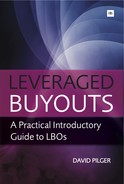Chapter 1: What Is An LBO?
If you’re looking for a job or about to start a new job in investment banking or corporate finance you’re probably going to have to know a thing or two about companies buying other companies. You may have picked up this book because you are just curious to know more about the workings of corporate finance and financial transactions. Well, you have come to the right place. But before we get started and dive into the makings of an LBO transaction, we first need to define what exactly an LBO is.
An LBO or leveraged buyout is, simply put, one company buying another company and using a large amount of debt to do it. That’s it. So ‘why all the fuss?’ you might ask. Why does this type of transaction get set aside from other types of mergers and acquisitions? The answer lies in the inherent risks that go along with a transaction that is financed primarily with borrowed money.
“An LBO is, simply put, one company buying another company and using a large amount of debt to do it.”
There are a few things that we need to recognize about the debt that is used in a leveraged buyout transaction. The first is that the debt used to acquire the target company is often secured by the assets of the target. In other words, a potential buyer does not necessarily need to possess the financial means to purchase a target company. Instead, the target company just needs to have enough available collateral, in the form of its assets, to allow an outside buyer to obtain debt financing (secured by the target’s assets) to pay for the cost of the transaction. Debt financing can also be secured by the assets of the buyer, but naturally using someone else’s assets as collateral is always considered more attractive than pledging one’s own assets as security for debt financing.
The second point to mention about the debt is that it can come in the form of bonds or bank loans. In the case of bonds, this means that the debt is issued and typically sold to investors in the capital markets. There is a fixed coupon rate that the target company must pay to its creditors (i.e. the purchasers of the bonds), which is dictated under the terms of the bond at issuance. The high levels of debt associated with leveraged buyouts, relative to the amount of equity in the target company, often results in the bonds being rated as junk or below investment grade. As credit ratings are used to gauge the risk of default, it should come as no surprise that loading up a company with debt will naturally increase the risk of default – and the higher the risk, the higher the interest rate the market is going to demand for lending.
“Lending in an LBO is frequently syndicated amongst a group of banks in order to decrease the amount of lending exposure to any one borrower.”
In the case of bank loans, financing comes directly from banks, rather than purchasers of bonds in the capital markets. The interest expense of bank loans is also often calculated as a variable rate. It is common for bank loans to charge the borrower an interest rate of LIBOR (defined below) plus an additional amount, termed spread, which is indicative of the risk associated with the borrower and the seniority of the loan in the case of default. (LIBOR is short for ‘London Interbank Offered Rate’ and is a daily rate that banks charge to borrow unsecured funds from each other for given periods of time.)
Another important aspect of bank loans is that the lending is frequently syndicated amongst a group of banks in order to decrease the amount of lending exposure to any one borrower. Using this strategy, banks are able to lend money while reducing the risk of bad loan write-downs by lending across a broader range of borrowers. For example, let’s say we own a bank. We decide to call it Friends Bank because we have friendly rates. We have a couple of choices regarding lending options:
- Option 1. We can lend $100 million to ABC Co and charge an interest expense of LIBOR plus 3.5%.
- Option 2. We can lend ABC Co $10 million and get nine other banks to lend ABC Co the remaining $90 million. The rate of interest charged will still be LIBOR plus 3.5%.
As part of option 2, the other banks will also call Friends Bank when they have loans that they want to syndicate out as well. At Friends Bank, we will end up participating as a lender in nine other syndicated loans, which gives the bank a total of ten syndicated loan deals it participates in. All of the loans that we agree to participate in charge an interest rate of LIBOR plus 3.5%. Which option is more attractive?
If you said option number two, you are correct. Under both scenarios, the amount of money earned from interest income is theoretically the same. What makes option number 2 the better option is apparent under a default scenario. In option 1, if ABC Co is unable to pay back its loan, Friends Bank solely takes on all the losses associated with the bad loan. However, under option 2, losses are spread over the ten lending institutions and interest income is still coming in from the other nine borrowers that are current with their interest payments.
In general, bank loans are far more complicated and multi-faceted than bonds. There are several different kinds of bank loans, including term loans, revolving credit facilities, and payment in kind loans, but the important thing to realize is that bank loans can have floating interest rates and often times are syndicated amongst several lenders, whereas bonds are fixed-rate instruments that are sold in the capital markets.
